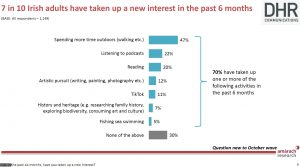
New interests and activities during a pandemic
In addition to exploring arts, culture and heritage participation by the public during the pandemic, as well as the media consumption patterns of Irish people during the height of the emergency, DHR Communications, with Amárach Research, also sought to better understand how people have been spending their time during the last six months. Unsurprisingly, with the availability of certain leisure activities – such as international travel and in-person socialising – greatly reduced, as well a much increased number of adults of out work, Irish people discovered a variety of new interests and activities with which to fill their time during the last six months.
A total sample of 1,149 was achieved with quotas set on gender, age, social class and region to achieve a sample aligned with national population. Field work was conducted between Wednesday, 7th and Friday, 9th October, with the research concerning itself with the period of the last six months. Key findings and analysis now follow:
- In the last six months, 70 per cent of Irish adults have taken up a new interest:
- 47 per cent have spent more time outdoors (walking, etc).
- 22 per cent have begun listening to podcasts.
- 20 per cent have taken up reading.
- 12 per cent have found a new artistic pursuit (writing, painting, photography).
- 11 per cent have begun using TikTok.
- 7 per cent have developed a new interest in history and heritage (eg researching family history, exploring biodiversity).
- 5 per cent have started sea swimming or fishing.
As one might reasonably expect, spending time outdoors topped the poll. The period surveyed saw generally good weather and an opportunity to meet with friends and family in the open air, in a more public health compliant manner, particularly as the most severe level of restrictions was eased.

Irish people already demonstrate a strong appetite for podcasts, with this year’s Reuters Digital News Report showing listenership growing to 40 per cent among adults. DHR and Amárach’s findings bear this out further. Given that so much of daily life has moved to virtual settings – specifically over video – podcasts might offer some reprieve from screentime, which has surely increased exponentially since the pandemic began.
That said, it is heartening that a fifth (20 per cent) of Irish adults have returned to the written word, and discovered [or rediscovered] reading. From the extensive sharing and resharing of quotes by the likes of Seamus Heaney, WB Yeats and Derek Mahon during the height of the first lockdown, literature and poetry have been widely turned to, as a source of solace and comfort amidst the hardship of the past six months. As well as consuming the arts, more than a tenth (12 per cent) of Irish adults took up a creative pursuit.
Although the short-form video-sharing app TikTok is largely seen as the domain of Gen-Z, that has not stopped more than a tenth (11 per cent) of Irish adults using the last six months to get to grips with the platform. According to an IPSOS MRBI study from the start of this year, TikTok is used by more than 90,000 Irish people (over the age of 15) daily.
Finally, a widely publicised and newly-found interest in sea swimming seems to be reflected to some degree in the findings, with five per cent of those surveyed saying they took it (or some other water-based activity, such as fishing) up during the last six months.
As part of the Amárach Public Opinion Tracker for Department of Health, the ‘Worry Index’ monitors the extent to which people are personally worried about the coronavirus, for roughly the same period of time as that which DHR’s findings relate to. Measured on a scale of 1 to 10, the index jumped from 5.6 to 7.3 in the space of two weeks in March, following an undulating decline throughout the first lockdown, before bottoming out in mid June at 5.2, after which it begins to rise again.
Similarly, the same Tracker monitors the emotional wellbeing of the country in terms of worry, anxiety, boredom, stress and frustration, among other, more positive indicators. Many of these indicators follow a similar pattern, fluctuating the most during the first lockdown, declining with the easing of restrictions and increasing alongside the rise in cases and restrictions more recently.
Overall, and while more in-depth research would be required to more concretely bear this out, DHR’s findings go some way in offering insight into how Irish people chose to spend their time during such a fraught and difficult period, as well the interests and activities that were turned to in search of reprieve.
